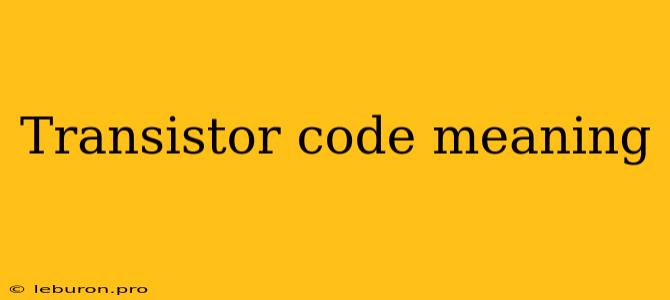Transistors are fundamental components of modern electronics, acting as the building blocks for countless devices. Their ability to control the flow of electricity makes them essential for circuits, computers, and even everyday appliances. But understanding how transistors work and what their "code" means is crucial for unlocking their full potential. This article delves into the world of transistor codes, exploring their meaning, significance, and practical implications.
The Building Blocks of Electronics: Transistors
Before diving into transistor codes, it's essential to understand the basic concept of transistors. Essentially, a transistor acts like a controlled switch, allowing or blocking the flow of electricity based on a small input signal. This signal can be a voltage or current, and it controls the larger current flowing through the transistor.
Types of Transistors: Understanding the Code
Transistors are typically classified into two primary types: bipolar junction transistors (BJTs) and field-effect transistors (FETs). These classifications are reflected in their respective codes, which provide a concise way to identify and understand their characteristics.
Bipolar Junction Transistors (BJTs)
BJT codes often start with a letter followed by a series of numbers. The first letter typically indicates the type of material used in the transistor, such as "N" for NPN transistors or "P" for PNP transistors. The following numbers denote the transistor's specific characteristics, such as current gain (hFE), voltage rating, and power dissipation.
Example: A 2N3904 transistor is a common NPN BJT often used in low-power applications. The "2N" prefix indicates a general-purpose transistor, while the "3904" identifies its specific characteristics.
Field-Effect Transistors (FETs)
FET codes generally follow a similar pattern to BJT codes. They often start with a letter followed by numbers, but the specific meaning of the letters and numbers may vary depending on the manufacturer. Some common prefixes include "2N", "J", and "IR".
Example: A 2N7000 transistor is a popular N-channel MOSFET, known for its high input impedance and switching speed. Again, the "2N" prefix indicates a general-purpose transistor, and the "7000" identifies its specific characteristics.
Understanding Transistor Codes: A Deeper Dive
While the initial letter and number sequence provide a general understanding of the transistor type, additional information is often included in the code to specify its functionality and limitations.
Suffixes and Other Designations
Some codes incorporate suffixes to further define the transistor's characteristics:
- "A" often denotes a high-frequency transistor.
- "C" might indicate a transistor designed for high-current applications.
- "H" suggests a high-voltage transistor.
- "T" might signify a temperature-stable transistor.
Manufacturer-Specific Codes
It's crucial to note that transistor codes can also be manufacturer-specific. Different manufacturers might use their own internal systems for designating their products. Therefore, consulting a manufacturer's datasheet is essential for understanding the complete meaning of a specific transistor code.
The Importance of Understanding Transistor Codes
Comprehending transistor codes is crucial for several reasons:
- Accurate Component Selection: Transistor codes provide a quick and efficient way to identify the correct component for a specific circuit.
- Performance Optimization: Understanding the characteristics associated with a transistor code enables engineers to select the optimal device for a specific application, ensuring optimal performance.
- Troubleshooting: When a circuit malfunctions, the transistor code helps identify the problematic component and facilitates troubleshooting.
Beyond Transistor Codes: The Future of Electronics
While transistor codes provide a structured system for identifying and understanding individual transistors, the future of electronics is moving towards integrated circuits (ICs) and more complex devices.
However, the fundamental principles of transistors and their code-based identification remain essential for comprehending the building blocks of modern electronics.
Conclusion
Understanding the meaning of transistor codes is key for anyone working with electronics. By deciphering the code, we can gain insights into the transistor's characteristics, application suitability, and limitations. From selecting the right components to troubleshooting circuits, a grasp of transistor codes is invaluable for engineers, hobbyists, and anyone seeking to delve deeper into the fascinating world of electronics.
